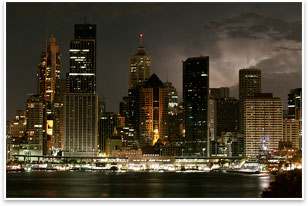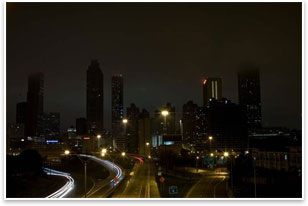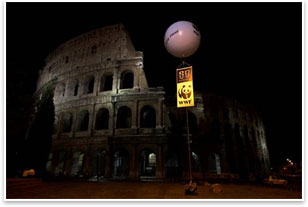Earth Hour to Raise Awareness for Climate Legislation
by Russell Boniface
Associate Editor
How do you . . . sponsor a global awareness campaign on climate change?
Summary: On Saturday March 28 at 8:30 p.m. local time millions of people, businesses, towns, and schools in more than 240 cities in 62 countries will turn off lights for one hour to make a statement about climate change legislation during Earth Hour 2009. Earth Hour is sponsored by the Washington, D.C.-based World Wildlife Fund (WWF) to show support for action on climate change. This will be the third Earth Hour in as many years.
Earth Hour means turning off non-essential lights
Earth Hour, started in 2007, is a symbolic event designed
to involve people, businesses, towns, and schools in supporting climate
change legislation. The WWF hopes Earth Hour 2009 will create political
momentum for enacting legislation and a global treaty to reduce greenhouse
emissions. Earth Hour is not a black out, but rather a “powering down” of non-essential lighting. WWF refers to it as more of a fade to grey than a fade to black. Many iconic structures worldwide are anticipated to have lights turned off. Some buildings plan to have non-essential lights turned off for that entire weekend starting with Friday night, March 27th.
Earth Hour, like New Years Eve, travels across time zones, starting
at 8:30 p.m. in New Zealand. Earth Hour 2007 was in Sydney, Australia,
when 2.2 million people and thousands of businesses turned out their
lights. Earth Hour then went global in March 2008, when over 400
cities, thousands of businesses, and more than 50 million people
around the world turned off their lights for one hour to demonstrate
a desire to slow the effects of climate change. An estimated 36 million
Americans participated. Many landmarks went dark, or faded to grey.
In the United States structures that turned off lights included the
Empire State Building, Chicago’s Sears Tower, the Golden Gate Bridge, and the Cola-Cola billboard in Times Square. International sites included the Sydney Opera House, Bangkok’s Wat Arun Buddhist temple, the Coliseum in Rome, Stockholm’s Royal Castle, and London’s City Hall.
Cities in 62 countries will be involved this year. Almost 100 cities
in the United States will participate including Atlanta, Chicago,
Dallas, Las Vegas, Los Angeles, Miami, Nashville, New York City,
and San Francisco. International cities include Hong Kong, Istanbul,
London, Manila, Mexico City, Moscow, Oslo, Rome, Singapore, Sydney,
Toronto, and Vancouver. Visit EarthHour.org for a complete list.
Earth Hour 2009 is a pivotal year
Leslie Aun, WWF vice president of media relations and managing director for Earth Hour US, says that when Earth Hour 2007 exceeded expectations, the WWF saw an opportunity to go global. “There were minor hopes in 2007, but it was a huge success,” she recalls. “More than 2 million people participated. Last year we had 400 cities and 50 million people globally, so it was very successful.”
 But this year, she says, is the most pivotal. “Now we have a president and a Congress who have made it very clear that climate change policy is going to be an important issue, and we have a big international summit to take place in Copenhagen in December, so 2009 will be very important. Earth Hour is meant to be an event to galvanize public interest, awareness, and support for action on climate change. The event does not advocate a specific treaty or law—there is no legislation to endorse one way or another—but it is really meant to give people a way to send a message to legislators that we care about climate change, are worried about the future of our planet, and want our leaders to take action.” But this year, she says, is the most pivotal. “Now we have a president and a Congress who have made it very clear that climate change policy is going to be an important issue, and we have a big international summit to take place in Copenhagen in December, so 2009 will be very important. Earth Hour is meant to be an event to galvanize public interest, awareness, and support for action on climate change. The event does not advocate a specific treaty or law—there is no legislation to endorse one way or another—but it is really meant to give people a way to send a message to legislators that we care about climate change, are worried about the future of our planet, and want our leaders to take action.”
 Why should architects participate? Why should architects participate?
Aun says the first thing people want to know is how much energy will be saved during Earth Hour. ‘We could turn off every light on the planet for an hour and it’s not really going to do much when it comes to the bigger issue of sustainability and climate change,” she points out. “The reason why architects and people in that industry should take part in Earth Hour is not just because they care about the planet and want action but also because they’re going to be incredibly important to the future of how we’re going to build the sustainable world. We can’t live and work and treat our planet well if those places aren’t built in responsible, interesting, and exciting ways, and architects will play an important role. One of the things we’ve been saying about the move toward sustainable living is it’s going to be led by innovators.”
 Some of the most iconic buildings worldwide will be turning lights off. Says Aun: “That
includes the Empire State Building, the Sears Tower, the Las Vegas
Strip, the Sydney Opera House, and Taipei 101. These are iconic buildings
emulated and envied in cities around the world. These buildings turning
off lights will send a message to the world about the need to take
action on our climate. These buildings, designed by the world’s great architects, will be the billboard by which we’re going to carry this message on climate change. It’s a people’s message and also a great moment for families to reconnect. It’s also a great way for businesses to look at ways they can operate more efficiently, and a great way for designers to think about ways they can design and build smarter.” Some of the most iconic buildings worldwide will be turning lights off. Says Aun: “That
includes the Empire State Building, the Sears Tower, the Las Vegas
Strip, the Sydney Opera House, and Taipei 101. These are iconic buildings
emulated and envied in cities around the world. These buildings turning
off lights will send a message to the world about the need to take
action on our climate. These buildings, designed by the world’s great architects, will be the billboard by which we’re going to carry this message on climate change. It’s a people’s message and also a great moment for families to reconnect. It’s also a great way for businesses to look at ways they can operate more efficiently, and a great way for designers to think about ways they can design and build smarter.”
|



